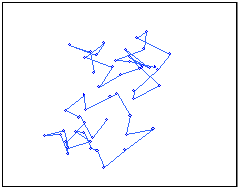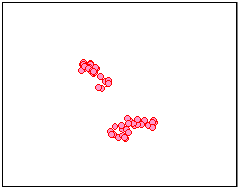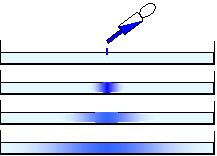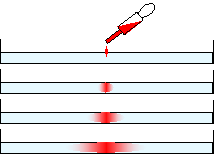Introduction:Particle size measurement of fine particles
2.Particle size measurement principle
As shown in Fig. 1, the particle size measurement range of our instruments by the light scattering method is 0.6 nm to 10 μm. Particles in this range change their position, orientation, and morphology from moment to moment due to Brownian motion such as translation and rotation in a solution. When these particles are irradiated with laser light and the scattered light emitted is detected, fluctuations of the scattering intensity depending on Brownian motion of the particles are observed. Therefore, by observing the temporal fluctuation of scattered light, the velocity (diffusion coefficient) of Brownian motion of the particle can be obtained, and the particle size can be estimated from them.
Our instruments uses this dynamic light scattering method to obtain the particle size distribution.
The following is a comparison of various particle size measurement methods.
Table 1. Comparison of various particle size measurement methods
| Measurement method | Measurement range of particle size (μm) |
Measurement physical quantity | Advantages | Disadvantages |
| Dynamic light scattering | 0.0006~10 | Fluctuation of scattered light | Capable of measuring particles smaller than sub-micron, No information of the particle required (Only refractive index and velocity of the solution required) | Easily dependent on scattering intensity, Easily affected by dust |
| Laser diffraction | 0.015~3000 | Diffraction scattering pattem | Simple, Wide measurement range | Refractive index of the particle required, Low measurement accuracy for particles smaller than submicron, Particle size calculation differs depending on the model |
| Centrifugal sedimentation method | 0.01~300 | Amount of transmitted light | Low cost, Simple | The density and refractive index of the particle required, Long measurement time for submicron particles, Absorption coefficient correction required |
| Field flow flactionation method | 0.01~1 | Amount of transmitted light | Capable of measuring particles smaller than submicron, High resolution | The density and refractive index of the particle required |
| Electrical sensing zone method (Coulter counter) | 0.1~1000 | Current/Voltage | Capable of measuring particle volume | Narrow measurement range, Replacement of pore required, Difficult to measure unknown particle size |
Since laser diffraction method uses the light diffraction phenomenon and Mie scattering phenomenon to determine the particle size, it is possible to measure in a wide particle size range, but it requires the refractive index of the particles. Moreover, measurement accuracy decreases considerably in the submicron region because the angle dependence of Mie scattering is not substantially observed.
The centrifugal sedimentation light transmission method is easy to operate, but has the disadvantage that the smaller the particle size is (the smaller the difference in specific gravity between a sample and a dispersion medium), the longer the measurement time takes.
The FFF method can obtain a high-resolution particle size distribution, but it requires particle density and refractive index.
The electrical sensing zone method can measure the particle volume, but it is desired to expand the dynamic range.
As you can see, each of the various particle size measurement methods has its own characteristics, but it can be seen that only the dynamic light scattering method can measure particle size which the electron microscope can measure, thus it can be used for ultrafine particle measurement.
Note) Other measurement principles
- Laser diffraction method: The particle size is determined by using the diffraction phenomenon of light (Fraunhofer phenomenon) and the Mie scattering phenomenon.
- Centrifugal sedimentation light transmission method: The particle size is measured from the relationship between the particles size settling in the medium and the settling velocity.
- FFF method (Field Flow Fractionation): Particles are injected into a duct filled with a cleaning liquid, and when an external force field is applied to the duct, the particles are deposited on the duct according to the applied external force. When a laminar flow is applied to such deposited particles, the particles at a high flow velocity position are carried farther. The particles at that time are detected by the light transmission method to obtain the particle diameter.
- Electrical sensing zone method : Detects fluctuations in electrical resistance that occur when particles cross an electric circuit formed through pores in an electrolyte solution, and the volume and number of particles are determined.
■Particle size from Brownian motion
Fine particles dispersed in a suspension or a solution usually have Brownian motion, which is slower for larger particles and faster for smaller particles. (Figs.2 and 3)

Figure 2. Brownian motion of small particles

Figure 3. Brownian motion of large particles
The difference in Brownian motion due to the difference in particle size is observed as the difference in the rate at which the particles diffuse in a solution, as shown in Fig. 4. Therefore, the particle size can be obtained by measuring the diffusion coefficient.
○Small particles ○Large particles


Figure 4. A model showing the difference in diffusion rate between small particles (left) and large particles (right)
When a sphere with a particle diameter d (diameter) is dispersed in a solvent having a viscosity η0, the relationship with the diffusion coefficient D is expressed by Stokes-Einstein equation as follows.

Here, k is the Boltzmann constant and T is the absolute temperature.


 Close
Close

